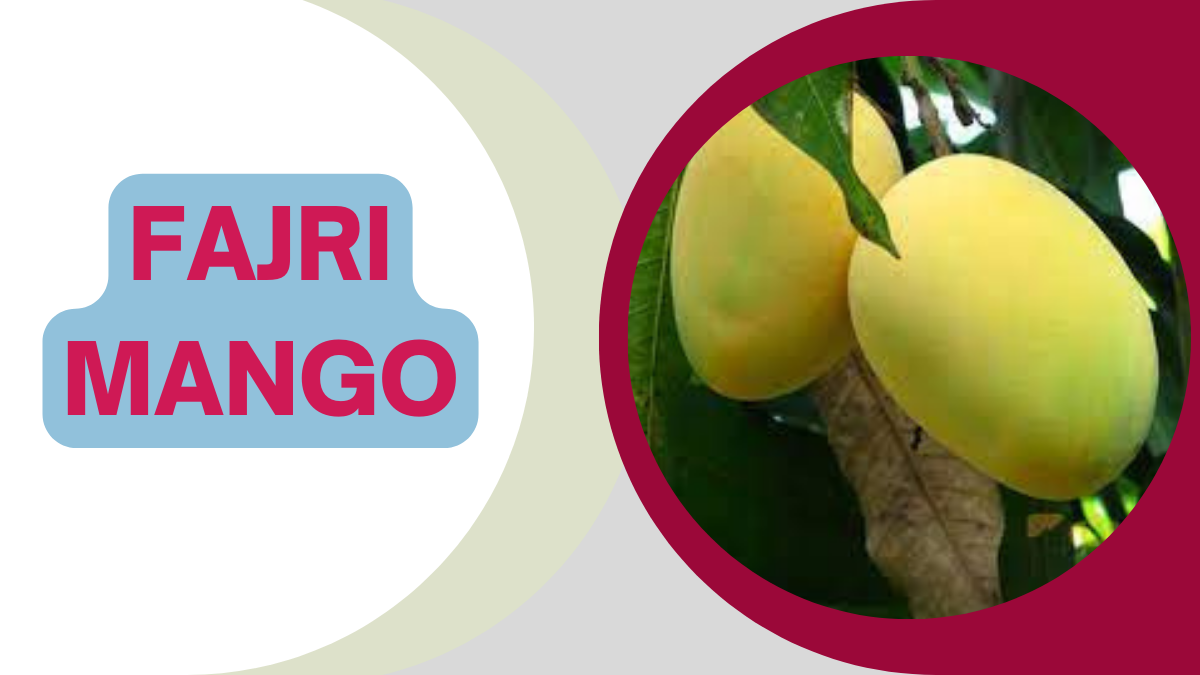Fajri Mango is a type of mango that is grown in Pakistan. It is named after the Fajri region in Punjab province, where it is cultivated. [1]
This mango is known for its unique taste and aroma, which makes it a favorite among mango lovers.[2]

History and Origin of Fajri Mango
The origin of Fajri Mango can be traced back to the Mughal period in India. It is believed that the Mughals brought the mango to India from Persia.
From there, it spread to other parts of the world, including Pakistan. Fajri Mango was first grown in the Fajri region of Punjab province, which is why it is named after the region.
Physical Characteristics of Fajri Mango
Here are some physical characteristics of Fajri Mango;

- Fajri Mango is a medium-sized mango.
- It typically weighs between 300 and 400 grams.
- The mango has a slightly oblong shape, with a small pointed tip at one end.
- The skin of Fajri Mango is thin and smooth.
- When the mango is unripe, the skin has a greenish-yellow color.
- As the fruit ripens, the skin turns into a yellowish-orange color with red patches.
Taste and Aroma of Fajri Mango
Fajri Mango is known for its unique taste and aroma. It has a sweet and juicy taste with a hint of tartness. The aroma of Fajri Mango is also distinct, with a strong fruity fragrance that fills the air.
Nutritional Value of Fajri Mango
Fajri Mango is not only delicious but also packed with nutrients. It is a rich source of:
- Vitamins A: 25% of the recommended daily intake (RDI)
- Vitamins C: 76% of the RDI
- Potassium: 6% of the RDI
- Fiber: 5% of the RDI
- One cup of sliced Fajri Mango contains about 107 calories.
Health Benefits of Fajri Mango
Fajri Mango is a delicious and nutritious fruit that provides several health benefits. Here are some of the health benefits of Fajri Mango:
1: Boosts the Immune System
Fajri Mango is rich in vitamin C, which is a powerful antioxidant that helps boost the immune system. It also helps protect the body against infections and illnesses.
2: Improves Digestion
Fajri Mango contains a high amount of fiber, which promotes healthy digestion and prevents constipation. It also helps regulate bowel movements and promotes a healthy gut.
3: Promotes Healthy Skin
Fajri Mango is a rich source of vitamin A, which is essential for maintaining healthy skin. It also contains antioxidants that help protect the skin against damage from the sun and other environmental factors.
4: Anti-Inflammatory Properties
Fajri Mango is believed to have anti-inflammatory properties, which can help reduce the risk of chronic diseases such as cancer, diabetes, and heart disease.
5: Regulates Blood Pressure
Fajri Mango contains potassium, which helps regulate blood pressure and promotes heart health.
6: Antioxidant Properties
Fajri Mango contains antioxidants such as beta-carotene and zeaxanthin, which help protect the body against oxidative stress and cell damage.
7: Hydrates the Body
Fajri Mango has a high water content, which helps keep the body hydrated and supports overall health.
8: Low-Calorie and Nutrient-Dense:
Fajri Mango is a low-calorie and nutrient-dense fruit, making it a healthy snack option for those watching their calorie intake. It is also rich in vitamins and minerals such as vitamin C, vitamin A, and potassium.
Culinary Uses of Fajri Mango
Fajri Mango is a versatile fruit that can be used in a variety of culinary applications. Here are some of the popular culinary uses of Fajri Mango:
Fresh Slices: Fajri Mango can be sliced and eaten fresh as a snack or added to fruit salads for a refreshing and nutritious treat.
Chutney: Fajri Mango chutney is a popular condiment in Indian cuisine. It is made by cooking ripe Fajri Mangoes with sugar, vinegar, and spices such as ginger and cumin.
Smoothies and Juices: Fajri Mango can be blended with other fruits and vegetables to make delicious and healthy smoothies and juices.
Pickles: Fajri Mango can be used to make pickles by marinating them in vinegar or brine with spices such as mustard seeds, cumin, and chili powder.
Ice Cream and Sorbet: Fajri Mango can be used to make delicious ice cream and sorbet by blending the ripe fruit with cream, milk, and sugar.
Mango Lassi: Fajri Mango can be used to make the popular Indian drink, Mango Lassi, by blending ripe Fajri Mango with yogurt, milk, and sugar.
Baked Goods: Fajri Mango can be added to baked goods such as muffins, cakes, and bread for a tropical twist.
Fajri Mango vs Other Mango Varieties
Fajri Mango is just one of the many varieties of mangoes available. While it shares some similarities with other varieties, such as the Alphonso and the Chaunsa, it has a unique flavor and aroma that sets it apart.
Fajri Mango is also known for its firm flesh, making it an excellent choice for salads and other culinary preparations.
Popular Fajri Mango Recipes
If you’re looking to try out some delicious Fajri Mango recipes, here are a few popular ones:
Fajri Mango Salad
Fajri Mango Festival
In Pakistan, the Fajri Mango Festival is celebrated every year to showcase the beauty and diversity of this mango variety.
The festival features various events, such as mango tastings, cooking competitions, and cultural performances. It is a celebration of the rich cultural heritage of Pakistan and its love for mangoes.
Fajri Mango is a unique and delicious variety of mango that is loved by people all over the world. Its sweet and juicy taste, combined with its distinct aroma, makes it a favorite among mango lovers.
Fajri Mango is also packed with nutrients and has several health benefits. Whether you enjoy it as a snack or use it in culinary preparations, Fajri Mango is sure to delight your taste buds.
FAQs
What does Fajri Mango taste like?
Fajri Mango has a sweet and juicy taste with a hint of tartness.
Where is Fajri Mango grown?
Fajri Mango is primarily grown in the Fajri region of Punjab province in Pakistan.

